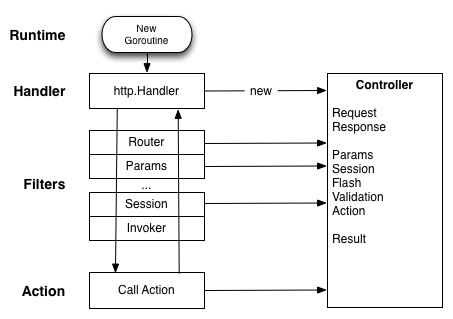Revel is a batteries-included web framework in the spirit of Rails or Play! Framework. Many of the same (proven) ideas are incorporated in the framework design and interface.
Revel makes it easy to build web applications using the Model-View-Controller (MVC) pattern by relying on conventions that require a certain structure in your application. In return, it is very light on configuration and enables an extremely fast development cycle.
Here is a quick summary:
There are many excellent overviews of MVC structure online. In particular, the one provided by Play! Framework matches our model exactly.
Here is an overview of the request processing framework.

Concept summary:
Revel builds on top of the Go HTTP server, which creates a go-routine (lightweight thread) to process each incoming request. The implication is that your code is free to block, but it must handle concurrent request processing.
The Revel handler does nothing except hand the request to the Filter chain for processing and, upon completion, apply the result to write the response.
By default, the Revel handler will be registered on "/" to receive all
incoming connections. However, applications are free to override this behavior
– for example, they may want to use existing http.Handlers rather than
re-implementing them within the Revel framework. See the FAQ for
more detail.
Filters implement most request processing functionality provided by Revel. They have a simple interface that allows them to be nested.
The “Filter Chain” is an array of functions, each one invoking the next, until
the terminal filter stage invokes the action. For example, one of the first
Filters in the chain is the RouterFilter, which decides which Action the
request is meant for and saves that to the Controller.
Overall, Filters and the Filter Chain are the equivalent of Rack.
Each HTTP request invokes an action, which handles the request and writes the response. Related actions are grouped into controllers. The Controller type contains relevant fields and methods and acts as the context for each request.
As part of handling a HTTP request, Revel instantiates an instance of your
Controller, and it sets all of these properties on the embedded
revel.Controller. Revel does not share Controller instances between requests.
A Controller is any type that embeds *revel.Controller (directly or indirectly).
type AppController struct {
*revel.Controller
}
An Action is any method on a Controller that meets the following criteria: * is exported * returns a revel.Result
For example:
func (c AppController) ShowLogin(username string) revel.Result {
..
return c.Render(username)
}
The example invokes revel.Controller.Render to execute a template, passing it the
username as a parameter. There are many methods on revel.Controller that
produce revel.Result, but applications are also free to create their own.
A Result is anything conforming to the interface:
type Result interface {
Apply(req *Request, resp *Response)
}
Typically, nothing is written to the response until the action and all
filters have returned. At that point, Revel writes response headers and cookies
(e.g. setting the session cookie), and then invokes Result.Apply to write the
actual response content.